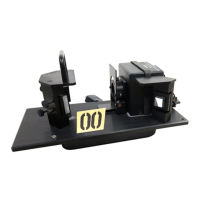AQ-00073-000, Rev. 7 22
3. Choose your reflectance sample method from the UV Winlab software or manually
set all instrument parameters as desired.
4. Perform a background correction scan.
5. Replace the reflectance standard at the sample reflectance port with your sample.
6. Execute a sample scan and save the scan data.
7. Multiply the values recorded in the resulting scan by the known spectral reflectance
factor values of the reflectance standard to determine the actual reflectance of the
sample. If your reflectance standard is an uncalibrated USRS-99-010 from Lab-
sphere, you can use the reflectance data in Appendix B.
0°/Hemispherical Reflectance Factor Measurements
The integrating sphere of the accessory has two sample holders for the sample reflectance port.
The standard sample holder is designed to position the sample for illumination by the sample
beam at an 8° incident angle. The second sample holder is designed for normal, 0° incidence.
With the 0° sample holder in place, any specular component of reflection from the sample is
excluded from measurement, since this component is directed out of the sphere through the
transmittance sample entrance port. Therefore, the 0° sample holder may be used to make 0°/d
reflectance factor measurements. The procedure for such measurement is as follows:
1. Remove the 8° sample holder from the reflectance sample port and install the 0°
sample holder.
2. Load a diffuse reflectance standard at the sample port.
3. Choose your reflectance sample method from the UV Winlab software or manually
set all instrument parameters as desired.
4. Perform a background correction scan.
5. Replace the reflectance standard at the sample reflectance port with your sample.
6. Execute a sample scan and save the scan data.
7. Multiply the values recorded in the resulting scan by the known spectral reflectance
factor values of the reflectance standard to determine the actual reflectance of the
sample. If your reflectance standard is an uncalibrated USRS-99-010 from Lab-
sphere, you can use the reflectance data in Appendix B.
Note:
Measurements performed using the specular excluded geometry should always be
interpreted with caution. The transmittance port may not be completely effective in remov-
ing the specular reflection component.
Reflectance Measurement of Non-Ideal Samples
Two simple ideal geometric reflectance distributions may be described: perfect specular reflec-
tion, and perfect diffuse reflection. Perfect specular reflection is simply reflection according to
Fresnel's law, without scattering. Perfect diffuse reflection is reflection according to Lambert's
law. For the purposes of integrating-sphere-based reflectometry, the Spectralon standards pro-
vided with this accessory serve as an excellent approximation to the ideal of perfect Lambertian
reflection, while a clean, flat, first-surface mirror provides an excellent approximation to the

